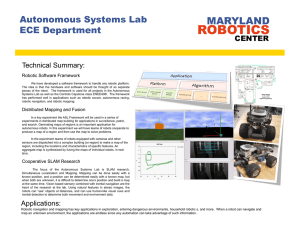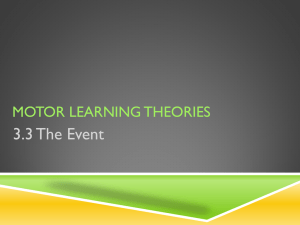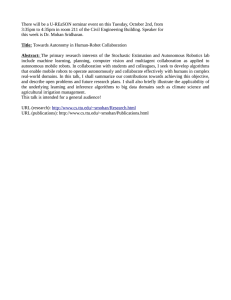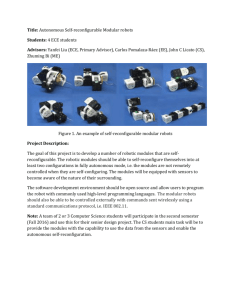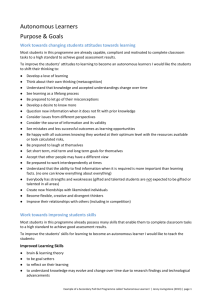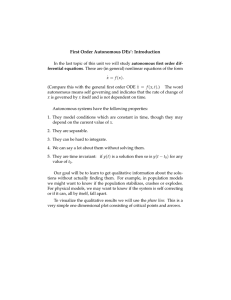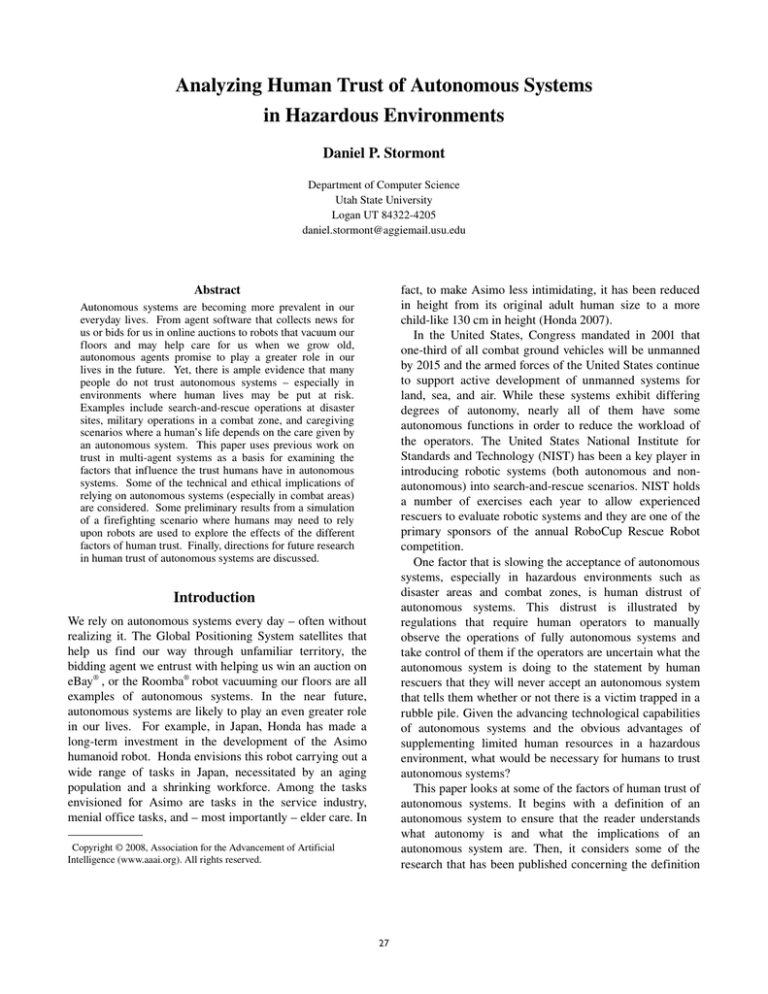
Analyzing Human Trust of Autonomous Systems
in Hazardous Environments
Daniel P. Stormont
Department of Computer Science
Utah State University
Logan UT 84322-4205
daniel.stormont@aggiemail.usu.edu
fact, to make Asimo less intimidating, it has been reduced
in height from its original adult human size to a more
child-like 130 cm in height (Honda 2007).
In the United States, Congress mandated in 2001 that
one-third of all combat ground vehicles will be unmanned
by 2015 and the armed forces of the United States continue
to support active development of unmanned systems for
land, sea, and air. While these systems exhibit differing
degrees of autonomy, nearly all of them have some
autonomous functions in order to reduce the workload of
the operators. The United States National Institute for
Standards and Technology (NIST) has been a key player in
introducing robotic systems (both autonomous and nonautonomous) into search-and-rescue scenarios. NIST holds
a number of exercises each year to allow experienced
rescuers to evaluate robotic systems and they are one of the
primary sponsors of the annual RoboCup Rescue Robot
competition.
One factor that is slowing the acceptance of autonomous
systems, especially in hazardous environments such as
disaster areas and combat zones, is human distrust of
autonomous systems. This distrust is illustrated by
regulations that require human operators to manually
observe the operations of fully autonomous systems and
take control of them if the operators are uncertain what the
autonomous system is doing to the statement by human
rescuers that they will never accept an autonomous system
that tells them whether or not there is a victim trapped in a
rubble pile. Given the advancing technological capabilities
of autonomous systems and the obvious advantages of
supplementing limited human resources in a hazardous
environment, what would be necessary for humans to trust
autonomous systems?
This paper looks at some of the factors of human trust of
autonomous systems. It begins with a definition of an
autonomous system to ensure that the reader understands
what autonomy is and what the implications of an
autonomous system are. Then, it considers some of the
research that has been published concerning the definition
Abstract
Autonomous systems are becoming more prevalent in our
everyday lives. From agent software that collects news for
us or bids for us in online auctions to robots that vacuum our
floors and may help care for us when we grow old,
autonomous agents promise to play a greater role in our
lives in the future. Yet, there is ample evidence that many
people do not trust autonomous systems – especially in
environments where human lives may be put at risk.
Examples include search-and-rescue operations at disaster
sites, military operations in a combat zone, and caregiving
scenarios where a human’s life depends on the care given by
an autonomous system. This paper uses previous work on
trust in multi-agent systems as a basis for examining the
factors that influence the trust humans have in autonomous
systems. Some of the technical and ethical implications of
relying on autonomous systems (especially in combat areas)
are considered. Some preliminary results from a simulation
of a firefighting scenario where humans may need to rely
upon robots are used to explore the effects of the different
factors of human trust. Finally, directions for future research
in human trust of autonomous systems are discussed.
Introduction
We rely on autonomous systems every day – often without
realizing it. The Global Positioning System satellites that
help us find our way through unfamiliar territory, the
bidding agent we entrust with helping us win an auction on
eBay® , or the Roomba® robot vacuuming our floors are all
examples of autonomous systems. In the near future,
autonomous systems are likely to play an even greater role
in our lives. For example, in Japan, Honda has made a
long-term investment in the development of the Asimo
humanoid robot. Honda envisions this robot carrying out a
wide range of tasks in Japan, necessitated by an aging
population and a shrinking workforce. Among the tasks
envisioned for Asimo are tasks in the service industry,
menial office tasks, and – most importantly – elder care. In
Copyright © 2008, Association for the Advancement of Artificial
Intelligence (www.aaai.org). All rights reserved.
27
trust (or, symmetrically, distrust) is a particular level
of the subjective probability with which an agent
assesses that another agent or group of agents will
perform a particular action, both before he can
monitor such action (or independently of his
capacity ever to be able to monitor it) and in a
context in which it affects his own action. When we
say we trust someone or that someone is
trustworthy, we implicitly mean that the probability
that he will perform an action that is beneficial or at
least not detrimental to us is high enough for us to
consider engaging in some form of cooperation with
him.
Gambetta’s work was extended to consider autonomous
agents by Castelfranchi and Falcone. In (Castelfranchi
1999), two critical extensions were identified. First, they
identified that only cognitive agents can “trust” another
agent. Second, they identified a framework of goals and
beliefs that were essential to trust another agent (whether
human or agent). The “core trust” element requires two
beliefs: that an agent that can perform a task to help you
achieve a goal has the ability to perform the task and the
desire to perform the task. If both of these beliefs are
satisfied, then the “reliance” element comes into play,
where you are relying on the agent to perform the task you
believe it is capable of and willing to do.
Some additional work in the area of trust for autonomous
systems has been performed as part of the ALADDIN
project. In (Ramchurn 2004), two principle components of
trust were identified: confidence (do I believe the agent can
perform the desired task) and reputation (has this agent
been successful in the past and have others trusted this
agent with good results).
Similarly, Fullam and Barber (Fullam 2007a) explore
two sources for trust information: experience and
reputation. The paper utilizes the Agent Reputation and
Trust (ART) Testbed to investigate reputation exchange and
the value of experience with an agent in a simulation of art
appraisals. The ART Testbed is also used for an annual
competition in agent trust relationships. The ART Testbed
interface is shown in figure 2 (Fullam 2007b).
and formalizing of the concept of trust – especially as it
applies to autonomous systems. Using this framework of
existing research into trust, a computer simulation of a
hazardous environment – in this case a brush fire
simulation – that simulates both human and robotic
firefighters is introduced as a testbed for exploring the
factors of trust. The simulation results are reported and
interpreted with regard to the components of human trust
in autonomous systems. Finally, conclusions about the
simulation results are reported and opportunities for future
work in this area are identified.
What is an Autonomous System?
The dictionary definition of autonomy is: “independence
(Houghton Mifflin 2007).” A good definition of the term
autonomous robot is: “Autonomous robots are robots which
can perform desired tasks in unstructured environments
without continuous human guidance (Wikipedia 2008).”
The critical element in this definition is that an
autonomous robot (or system) operates in an unstructured
environment, that it can perform desirable tasks, and that it
does not require human intervention on a regular basis. As
seen in figure 1, autonomy falls into a spectrum; from no
autonomy (tele-operated or “remote control” robots) to full
autonomy (robots that act with no human intervention). In
between these extremes are robots with partial autonomy
(e.g., an “intelligent” manipulator that can be commanded
to a desired position or directed to perform a task without
continuous input from the operator) and robots with sliding
autonomy (the degree of autonomous operation is
selectable by the operator).
Figure 1. Examples of degrees of autonomy for autonomous
systems, from no autonomy to full autonomy.
What is Trust?
While trust has been discussed by philosophers and theists
since before the time of written history, it really became a
topic of research as a result of the work of Diego Gambetta
(Gambetta 1988). Gambetta’s approach to trust tended to
focus on human interactions, rather than on autonomous
systems, but his definition for trust is a good starting point:
Figure 2. The Agent Reputation and Trust (ART) Testbed interface.
28
Evidence of concerns about utilizing armed robots
occurred recently with the deployment of the Special
Weapons Observation Remote Direct-Action System
(SWORDS) to Iraq. Three of these armed robots (which
are tele-operated, not autonomous – see the photograph in
figure 4) were sent into the theater, but the weapon on the
robot has never been fired in a combat situation and there
have been a number of rumors about the robots being
undependable and taken out of service – even though there
is no evidence to back up the rumors (Popular Mechanics
2008).
Implications of Distrust of Autonomous
Systems
As Robin Murphy of the Center for Robot-Assisted Search
and Rescue noted (Murphy 2004):
One impact of the human side is that rescue workers
today refuse to consider fully autonomous systems
designed to act as ‘yes/no there’s something down
there’ search devices. Scenarios where a swarm of
hundreds of robot insects are set loose to
autonomously search the rubble pile and report to a
single operator not only appear impractical for
search (and certainly for structural assessment,
victim management, and extrication as well), but
also ignore the organizational context of USAR,
which has a hierarchy of operators who check and
verify any findings from dogs, search cameras, or
other sources.
The lack of trust in autonomous systems also manifests
itself in regulatory guidance. The United States Federal
Aviation Administration does not allow the operation of
unmanned aerial vehicles in the national airspace, with the
exception of some specially identified operating areas
(usually military airspace) and in national emergencies,
with the proper coordination. Operation of autonomous air
vehicles is never allowed in national airspace (Lazarski
2001). This requirement for maintaining human control
over systems capable of operating autonomously has made
their employment more difficult than necessary. A recent
study found that operators of unmanned aircraft were the
most over-utilized and overstressed operators of aircraft
Another critical issue of autonomous systems, especially
when operated in combat areas, is the legal ramifications.
The Law of Armed Conflict (LOAC) would seem to apply
to the use of robotic systems in a combat zone. This means
that the commander of a unit utilizing robotic systems
could be held legally accountable for civilian deaths,
injuries, and loss of property resulting from the use of a
robotic system (Lazarski 2001).
More important than the legal ramifications are the
moral ramifications. Should an autonomous combat
vehicle, such as the Unmanned Combat Air Vehicle shown
in figure 3, be allowed to make targeting decisions using its
own heuristics? Who is responsible if it erroneously
targets innocents? Should life and death decisions be made
by an autonomous system? Consideration of the moral
aspects of autonomous systems have been lagging the
technical aspects.
Figure 4. The SWORDS armed reconnaissance robot.
Factors Affecting Trust
Using the two components of trust identified in (Ramchurn
2004) as a starting point, it is apparent that autonomous
systems (or for that matter, robots in general) tend to not
have a good reputation. While the reasons for this are not
entirely clear, given the obvious advantages of being able
to use robots in hazardous environments instead of risking
human lives; it is apparent that the other trust component –
namely, confidence – plays a key role in the poor
reputation of robots.
One reason for a lack of confidence in robotic systems is
their lack of reliability in field conditions. A 2004 study of
commercially available ruggedized robots operating in
field conditions showed a mean-time-between-failures
(MTBF) of 12.26 hours and an availability rate of 37%
(Carlson 2004). Obviously, robots need to become much
more reliable if humans are going to have confidence in
them.
However, a more important reason for lacking
confidence may be the unpredictability of autonomous
systems. When working with humans, we usually can
anticipate their actions in a wide range of circumstances –
especially if we have trained with them, as is the case in
rescue crews and combat teams. But autonomous systems
have a tendency to surprise even their creators. This is one
of their strengths, as they can often come up with an
unanticipated solution that is better than any solution that
Figure 3. An unmanned combat air vehicle. (Illustration from
DARPA.)
29
could be programmed in to the system, but this
unpredictability can be very disconcerting in hazardous
environments.
they are called upon. The trust value decreases more
rapidly than it increases to reflect the human bias against
autonomous systems. The trust threshold will lower if the
workload gets too high for the human firefighters (there are
too many fires for them to extinguish) and as the human
firefighters get fatigued from fighting too many fires
consecutively. The interface has graphs that display the
number of fires extinguished by the human and robotic
firefighters and an indication of the current trust level.
A Simulation of Human-Robot Interactions
In order to better understand distrust of autonomous
systems in hazardous environments, a firefighting
simulation was created in the NetLogo simulation
environment (Wilenski 1999).
A screenshot of the
simulation is shown in figure 5.
Simulation Results
The results from the initial version of the simulation are
not especially surprising. As can be seen in the graph in
figure 6, the robot firefighters are not called upon initially.
At this point, the human trust level is still below the
threshold level. However, once the situation starts to get
out of hand, the human firefighters start to call upon the
robotic firefighters to assist in extinguishing the fires.
Once the situation is under control, the trust in the robotic
firefighters starts to drop a little bit as the human
firefighters’ biases come into play. Finally, as the human
firefighters grow fatigued toward the end of the simulation,
they call upon the robotic firefighters again to help put out
the last of the fires.
Figure 5. A simulation of a firefighting scenario developed in
NetLogo.
The simulation has two types of agents at present:
human firefighters and robotic firefighters. An equal
number of firefighters are randomly distributed in a
grassland environment. The number of firefighters is
determined by the value of a number of human firefighters
variable that is selected by the user of the simulation using
a “slider bar” on the interface. The variable values are all
set before a run of the simulation and can not be changed
during a run. At each turn of the simulation, fires start
randomly according to the setting of a rate of fires variable
on one of the sliders. A fire can be extinguished if a
firefighter is in the same location as the fire for one turn of
the simulation. Any fires that are not extinguished will
spread into an adjacent location, if that location has not
already been burned (which is indicated by the black
patches on the map). The direction of the spread of the fire
is determined by a random wind direction variable, which
is set at the start of the turn and affects the spread of all
existing fires in the same manner. Another slider can be
used to determine the trust threshold and the initial trust
value. The initial trust value is the trust the human
firefighters have in the robotic firefighters at the beginning
of the simulation. The trust threshold is the value below
which the human firefighters will not call on the robotic
firefighters. The trust value can increase (or decrease)
based on the performance of the robotic firefighters when
Figure 6. Graphs illustrating the results of a typical simulation
run. The top graph shows the number of fires extinguished (with
separate traces for the human and robotic firefighters) and the
bottom graph shows the changing level of trust the human
firefighters have in the robotic firefighters over time.
The results of the simulation do validate the expectations
for the scenario, but the simulation is currently too simple
to provide answers to the really interesting questions about
the human-robot trust relationship in a hazardous
30
environment. To answer these questions, the firefighting
simulation needs to be made more complex, to reflect the
trust factors that have been identified in the literature.
Conclusion and Future Work
The survey of the current literature on trust of autonomous
systems should make it apparent that there is no
widespread agreement on the factors that contribute to
human trust in robots – especially in hazardous
environments. Some important factors are experience and
reputation. The experience will come from individual
humans who take a chance on autonomous systems out of
necessity or curiosity. The reputation will come from the
prevalence of autonomous systems that reliably answer a
need that can not be satisfied by humans, or at least, not
without greater risk. At present, there has been some
experience with robotics in combat zones that has led to
increasing demand for robots that can perform the most
dangerous tasks (such as explosives disposal) under human
control, but without putting a human at risk (Gates 2008).
However, the use of autonomous systems in combat zones
or other hazardous environments, continues to be a
capability that is far in the future (OSD 2007).
To try to identify the elements of trust that are most
critical to human acceptance of robotic assistance in
hazardous environments, the firefighting simulation is
going to be developed further. Variables that represent
some of the elements of trust identified in the literature,
such as reliability and predictability, are going to be added
to the interface. Also, the simulation is going to be made
more realistic by including human trust levels in other
humans and heterogeneous robot types. For example,
robots that move more slowly than other types, but can
carry more fire suppressant or robots that can traverse
rough terrain.
In addition to extending the firefighting simulation, a
more diverse scenario could also promise to yield
interesting insights into human-robot trust issues. The
RoboCup Federation has developed a simulation of rescue
operations on a city-wide scale (see figure 7). The
RoboCup Rescue Simulation currently simulates human
police, ambulance, and firefighting agents, under the
control of dispatcher agents (RoboCup 2008).
The
simulation can be readily extended to add in robotic police,
ambulance, and firefighting agents. It could also be
possible to create a human user interface for the role of
dispatcher, to run human trials on human-robot trust. In
other words, what would an autonomous system need to do
for an experienced dispatcher to decide to dispatch a robot
to assist a human agent or in place of a human agent?
There are still many questions to answer, but the answers
to these questions could benefit not only the designers of
autonomous systems, but also the potential users of these
systems, and – ultimately – all of us.
Figure 7. The user interface for the RoboCup Rescue Simulation.
References
Castelfranchi, C. and Falcone, R., 1999. “Principles of
Trust for MAS: Cognitive Autonomy, Social Importance,
and Quantification,” Proceedings of ICMAS 1999. Online:
http://aois.org/99/castelfranchi-ICMAS-paper.rtf.
Fullam, K., 2007a. Agent Reputation and Trust Testbed.
Online: http://www.lips.utexas.edu/art-testbed/.
Fullam, K. and Barber, K., 2007b. “Dynamically learning
sources of trust information: experience vs. reputation,”
Proceedings of the 6th International Joint Conference on
Autonomous Agents and Multiagent Systems (AAMAS
2007).
Gambetta, D. ed., 1988. Trust: Making and Breaking
Cooperative Relations, New York, NY: Basil Blackwell
Ltd. Online: http://www.nuffield.ox.ac.uk/users/gambetta
/gambetta trust book.pdf.
Gates, R., 2008. Secretary Gates Remarks at MaxwellGunter Air Force Base, Montgomery Alabama,
DefenseLink News Transcript, April 21, 2008. Online:
http://www.defenselink.mil/utility/printitem.aspx?print=htt
p://www.defenselink.mil/transcripts/transcript.aspx?transcr
iptid=4214.
Houghton Mifflin, 2007. “Autonomy,” American Heritage
Dictionary of the English Language. Boston, Mass.:
Houghton Mifflin.
Honda, 2007. Asimo: The World’s Most Advanced
Humanoid Robot. Online: http://asimo.honda.com/default.
aspx.
Lazarski, A., 2001. “Legal Implications of the Uninhabited
Combat Aerial Vehicle,” Air & Space Power Journal,
March 2001.
Murphy, R., 2004. "Rescue Robotics for Homeland
Security," Communications of the ACM, special issue on
Homeland Security, vol. 27, no. 3, March 2004, pp. 66-69.
Office of the Secretary of Defense, 2007. Unmanned
Systems Roadmap, 2007-2032. Online: http://www.acq.
osd.mil/usd/Unmanned%20Systems%20Roadmap.20072032.pdf.
Popular Mechanics, 2008. “The Inside Story of the
31
SWORDS Armed Robot ‘Pullout’ in Iraq: Update,”
Popular Mechanics Online. Online: http://www.popular
mechanics.com/blogs/technology_news/4258963.html
Ramchurn, S., et al, 2004. “Devising a Trust Model for
Multi-Agent Interactions using Confidence and
Reputation,” Applied Artificial Intelligence, 18, pp. 833852.
Online: http://users.ecs.soton.ac.uk/nrj/downloadfiles/jaai04.pdf.
RoboCup Rescue, 2008. Rescue Agents. Online: http://
www.robocuprescue.org/agentsim.html
Wikipedia, 2008. Autonomous Robot. Online: http://en.
wikipedia.org/wiki/Autonomous_robot.
Wilensky, U., 1999. NetLogo, Center for Connected
Learning and Computer-Based Modeling. Evanston, IL:
Northwestern University. Online: http://ccl.northwestern
.edu/netlogo.
32

